How To Set Up Good Lighting For Photos
Natural lighting tin either exist your best friend or worst enemy in a production photography shoot. Nail it, and the results will speak for themselves. Become it incorrect, and no amount of editing can save a photo from poor lighting.
Lighting and photographic camera settings determine the outcome of the entire shoot before it's even started, so a solid agreement of the basics of lighting volition assist yous achieve amazing product photos that you tin can utilise throughout your website and marketing efforts.
For near merchants, it's unlikely you'll take access to a photography studio and all of the equipment needed to shoot professional person product photos. So in this post, nosotros're going to look at how yous can chief DIY natural lighting, and create cute photos using either a smartphone or professional-form camera.
Shopify University Form: Product Photography
Photographer Jeff Delacruz shares how you tin can create your own photo studio and have cute product photos for less than $50.
Enroll for free
1. Find the right lighting conditions

The near crucial part of every photography setup is the lighting, and it's also the hardest to get correct.
There really is no quick fix, or one size fits all solution. Different products will require different lighting, and information technology's upwards to you to figure out what works best for your products. Once you get a handle on the basics, it'll exist a case of trial and error until you notice the perfect formula. Nosotros're going to focus specifically on natural lighting.
Natural lighting through a window is the ideal solution for a few reasons. First and foremost, everyone has admission to a window. Second, natural lighting coming through a window has a unmarried direction. This generates natural shadows, creating a 3D upshot by adding texture to your product, bringing it to life.
When shooting adjacent to a window, you want to shoot when the day is brightest. Take a await at the conditions. Is it a total sunny day or is it an overcast twenty-four hour period? To achieve the wait you're going for, full sunlight might not be what you need. This is where exercise, and figuring out what look yous prefer comes into play. As you tin meet beneath, shooting with natural lighting can make quite a difference in the highlights and shadows of your photo.
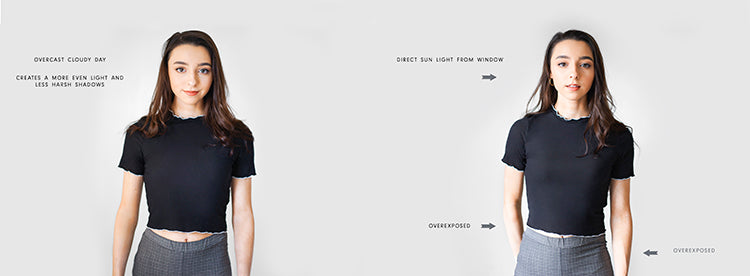
2. Harness natural lighting
Corking natural lighting is essential to achieving perfectly defined images. By controlling the shadows created from natural light, you can add together an chemical element of interest to your production photos.
Just one of the nigh anticipated things almost mother nature is that it's unpredictable, and and then natural lighting is too, often irresolute from one infinitesimal to the side by side. You need to exist prepared for every eventuality.

Equally the sunday changes and moves throughout the day, it affects the style the natural light shines through the window. Finding the best lite to shoot your product photos can be a challenge at the best of times. Keep an heart on how the light changes throughout the day to figure out when the sugariness spot is for that particular location.
There are three terms you lot should know when illuminating your subject with natural lighting:
- Front-lit is when indirect natural light hits a product head-on.
- Backlit is when it hits your subject from behind.
- Side-lit is when the low-cal comes from either side of the product.
Whatsoever bending of lighting yous adopt, information technology's important to note that each i casts a shadow on the opposite side.
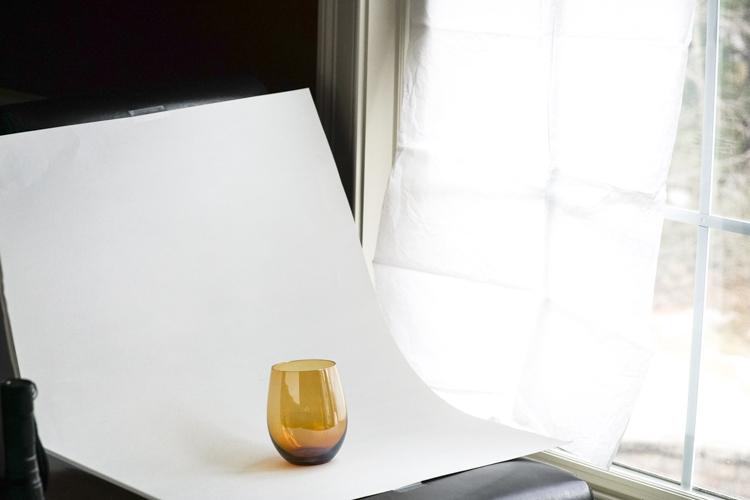
To become started using natural light, place a tabular array or chair next to a large window and prop a sweep (a large white sheet) against the wall. This will provide simply the correct combination of good lighting and soft shadows. The trick is to avoid straight sunlight every bit it will consequence in dark, cruddy shadows.
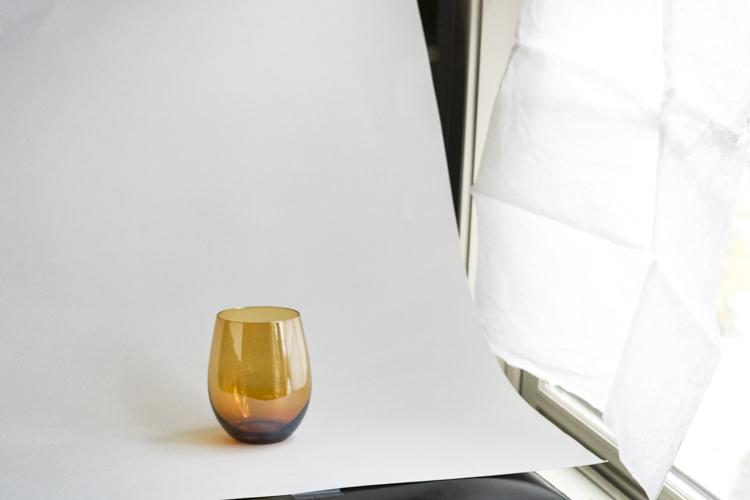
If the sunday is too strong, you don't need to completely scrap a photo shoot. Instead, agree a sparse white sheet, known as a diffuser, against the window to diffuse and soften the low-cal to create a less harsh effect. Avoid difficult light at all costs as it oftentimes makes colors look more than saturated, and volition highlight even the most minuscule flaw non visible to the naked heart.
How to utilize a reflector to fill up in shadows
If the sun suddenly decides to hibernate behind the clouds, causing the level of natural lite to drop, make certain you have a reflector on mitt to bounce and intensify lite to fill shadows. A reflector can exist a white foam board or any white screen. You can option up white foam boards from simply about any craft store or choice upwardly a reflector on Amazon.
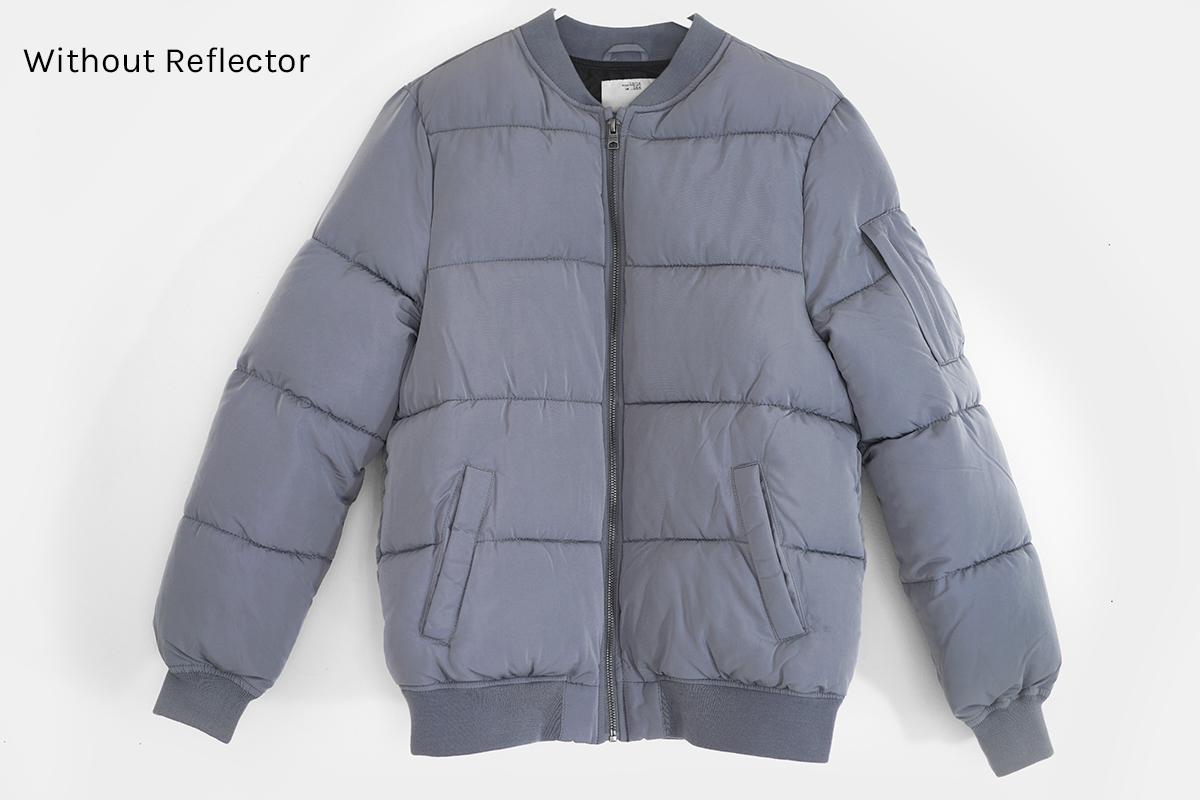
Without plenty natural light, the shadows from the creases on this jacket stand out.
If yous're using a reflector for the offset time, you tin can command the amount of natural light that bounces back past moving your reflector either further away or closer to your product. Using a white surface helps reflect natural light from the sun dorsum onto the production.
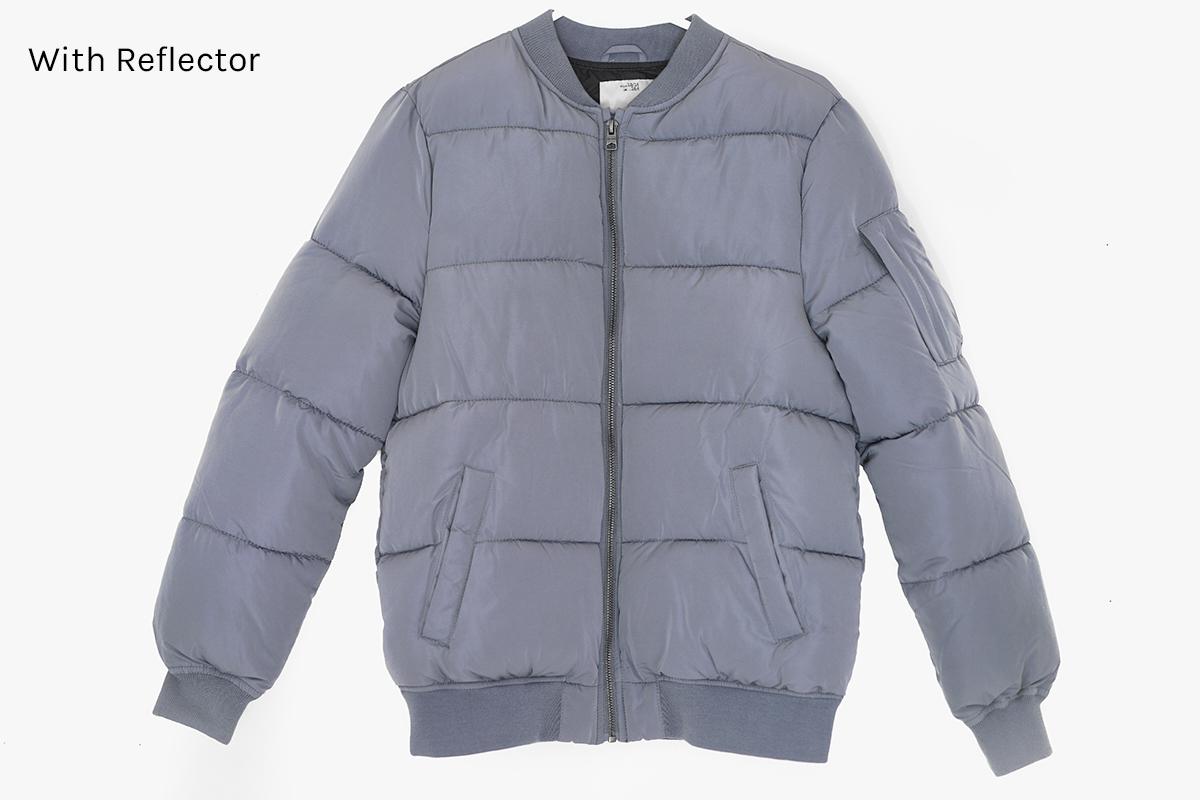
With a reflector, the creases become less prominent as the shadows are filled in by natural light.
Sentry where the light is coming from, and bounce the light in the contrary direction. Yous should shoot directly adjacent to your light source at a 90-degree bending, then reflect that light back onto the subject area. This will give your paradigm as much low-cal equally possible while also eliminating as much shadow as possible.
For my fashion photography model shots, I always keep the window to the right and my reflector to the left. This helps bounciness the light to places where there was niggling to no light, giving a much softer terminate to the photo.
Don't exist afraid to play with the angle of the reflector to find the right balance between shadows and lighting. When shooting a backlit production, try placing the reflector in forepart of the production so the natural low-cal tin bounce back onto it.
Side-lit products can produce particularly harsh shadows, so make sure you take your trusty reflector on manus, allowing the lite to bounce dorsum on the shadows and soften them.
3. Set up your product background
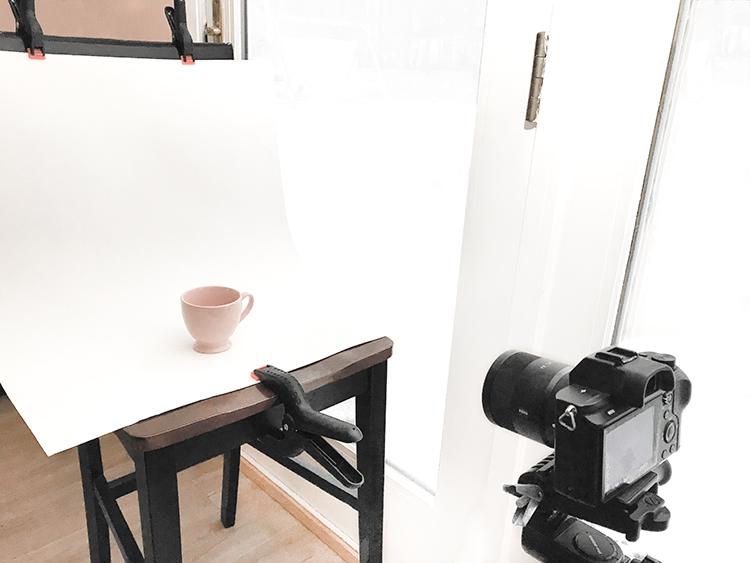
When shooting product photography, you lot're going to need an open space for setting upwardly your properties: another essential chemical element to attain swell photos using natural lighting.
Your properties should always be white, as white reflects natural light onto the production resulting in an evenly lit photo. A white backdrop is especially helpful in the editing process, as it makes it much easier to remove the background.
When shooting smaller products, you can either shoot on a tabular array with a large sheet of white paper taped to the wall backside the product. Or you tin push a chair up against the wall nether a large window. Tape or clamp a large sheet of white paper either to the top of the chair or the wall, depending on what angle y'all desire to shoot from.
If you're shooting bigger objects, buy a roll of white wallpaper and tape a few long strips to the wall. You could even employ a large white sail and let gravity take intendance of the balance.
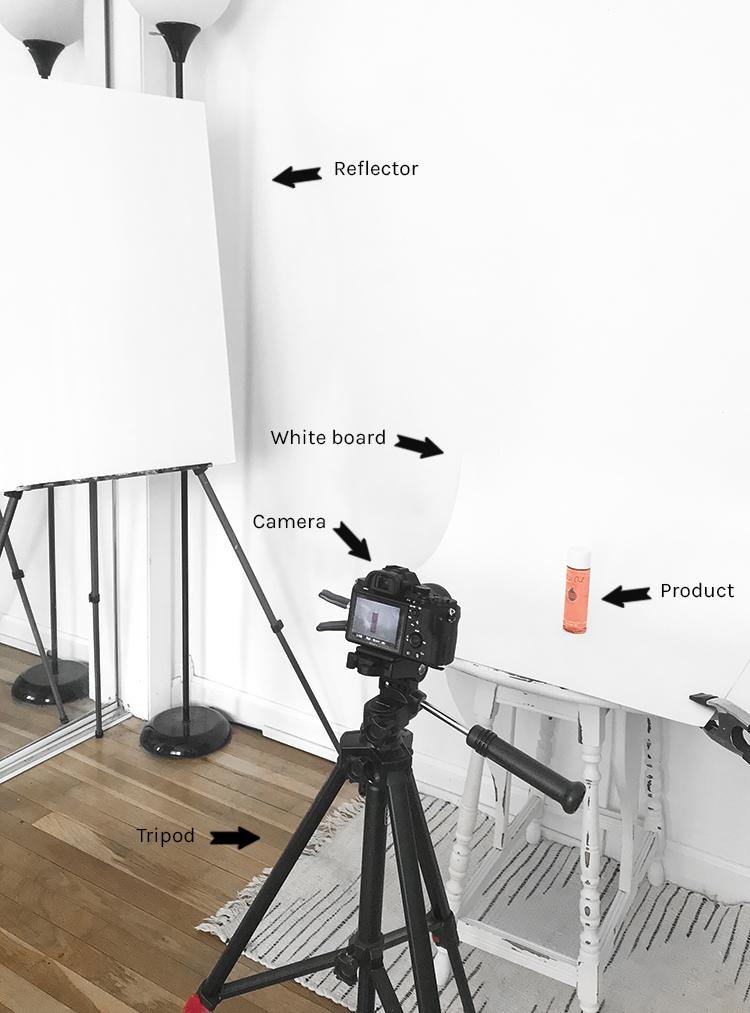
As you can run across, I'1000 shooting against a white wall, leaving plenty of room for a reflector and camera. I used a sturdy piece of white paper and aptitude it into a slightly curved shape. This helps make the background wait seamless and allows the light to bounciness dorsum onto the production.
To secure the paper, I clamped it downwardly with some spring clamps from a local hardware shop. If yous don't have any clamps, you lot could always just record the paper to the wall and tape the bottom to the ground, creating a slight curve in the paper.
Information technology's essential to secure your properties to ensure nil moves during the photography process. This helps reach consistent results; even the smallest change will affect the reflections and shadows.
4. Explore dissimilar camera angles

Through your product photos, yous demand to visually answer any questions that your product descriptions don't fully explain. That'southward why having a variety of camera angles is and then of import.
Give customers as many unlike perspectives to help showcase the key features of your product. The ultimate goal is to shoot your product from every angle, giving customers a 360 degree view of the product. Providing an all-around view is significantly more engaging every bit yous're visually providing extra production information, helping customers picture themselves using or wearing your product.

By taking product shots from unlike angles, you lot'll also inject some character and creativity into your photos. Equally a rule of thumb, your main hero paradigm should exist an center-level head-on view of your product. Information technology's recommended to have anywhere up to 12 additional supporting images highlighting the nigh important features.
If you're non certain what features you should capture, focus on features that showcase the quality of your product. Accept shut-ups of the textile, print item, texture, or even your products being put to use. Be sure to highlight the more detailed elements of your production that customers might want to inspect.

For anyone getting started with product photography, information technology's highly advisable to move the product around rather than moving your camera. Keep your camera and tripod in the same spot, and change the angle of your product instead of having to motility your camera. Keep the product in roughly the same place each time, just rotating its position. This ways your final shots will all be framed the same. And you'll maintain consistency, reducing post-photography editing.
For anyone with a chip more experience or fifty-fifty those with a very steady hand, you could play around with a variety of tripod-free camera angles. Try shooting the product from above instead of directly in front. Shooting from to a higher place allows you to include more items in your photo. This is especially useful when you desire to showcase a product line or in-context photo. Or why non have a go at shooting from a depression angle, making the product wait bigger?

These are the main camera angles y'all should be aware of and experiment with in your photo shoot:
- Middle-Level: Shows the product exactly the way we see it in reality. This is recommended for your hero image.
- Loftier Angle: Shows the product from above, as if you're looking down at information technology from an angle.
- Depression Bending: Shows the product from below, as if yous're looking up at the product.
- Bird's Eye: Shows the product directly from above, as if you're standing over the production.
- Slanted: Shows the production from one side, every bit if you're looking side-on at the product.
v. Utilize your camera's manual settings
The beauty of using a professional camera to shoot is that you can control every single attribute of the photo through various settings. Simply before y'all even become started with settings, you need to get your tripod set up up. Using a tripod is essential to getting the most out of your photographic camera settings. For those who don't take a tripod, a stack of books volition practise.
A tripod is necessary because it provides stability, minimizing tiny movements that tin ruin a neat photo. I'd recommend you lot make sure your tripod is in line with the product you're shooting, every bit this makes it easier when tweaking the settings as y'all accept photos.
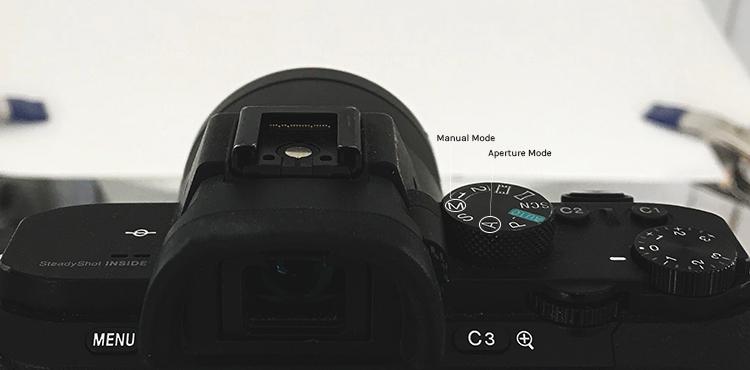
To achieve the best results, I'd recommend ever shooting in manual mode. Mastering manual fashion lets you accommodate to your surround, whether information technology's outdoors or an indoor studio, and shoot peak-notch photos in a multifariousness of lighting conditions.
Shooting in manual mode gives you the power to control all settings, without worrying nearly the incorrect automatic setting being used, like the wink. The main settings you should master to make the most of natural lighting are:
- Discontinuity
- ISO
- White balance
- Shutter speed
Aperture
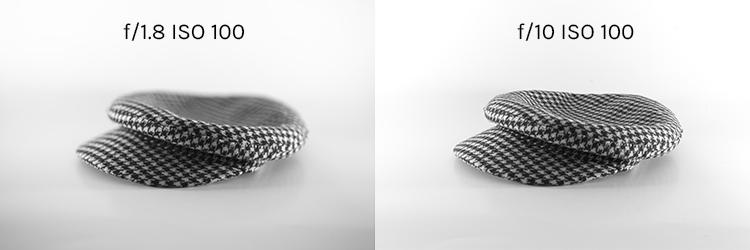
First, we'll await at aperture. I'd recommend you use a higher f-stop because information technology helps keep every detail in focus. I adopt to shoot betwixt f/8 and f/14 equally this keeps the entire product in focus without losing too much calorie-free.
If you want to make sure the entire production is in focus, utilise a setting higher up f/12. Some cameras may not go that high, so only utilize the highest setting available. Ultimately, the college the discontinuity the clearer the last photo volition be.
ISO

Next, allow'south get to grips with ISO. The ISO setting manages the photographic camera'south reaction to light. The lower your ISO, the less sensitive the camera is to lite and the higher the paradigm quality. But when the ISO setting is too high, images start to wait grainy or pixelated. When shooting in a dark environment, a higher ISO is needed, but the goal is to discover a adept remainder between improving the lighting and the epitome quality.
Once you become the right ISO setting co-ordinate to your surround, you'll achieve beautifully well-baked product photos. My studio has first-class natural lighting, so I usually stick to an ISO between 300-500 depending on the weather outside. On a specially cloudy day, I plough my ISO up loftier to warm the sensors up and then suit information technology until the image is nice and clean.
White balance

Choosing the right white balance volition hateful your camera accurately adjusts co-ordinate to the colour of your product in conjunction with the light. For beginners, y'all probably want to use the automatic white balance setting, then the camera automatically chooses the right setting according to the lighting.
One time you lot start getting a flake more confident with your photographic camera settings, I'd suggest you manually select the white balance setting that most accurately reflects what you meet. The goal is to get as close a match between what you lot come across in your photographic camera viewfinder and your optics. Despite existence a huge amplifier of natural lighting, it does take some getting used to and adjustments.
A sudden increase in sunlight or even particularly harsh sunlight tin exit your images beingness overexposed. An overexposed image is tough to right in post-photography editing—especially if yous're using a complimentary photo editing software—equally the particular is not well-baked enough due to the harsh lighting. Follow the communication to a higher place about harnessing natural light , and you'll take no problem working around it.
Shutter speed

When you've set the aperture, ISO and white rest, you can finally gear up your shutter speed. The shutter speed volition decide how long the shutter is open when taking photos. Longer shutter speeds assistance the photographic camera selection up more light, which makes for a beautifully well-baked photograph.
My height tip for getting the nigh of your shutter speed, and all the camera settings, is to use a tripod. Keeping the camera stable allows all the settings to work together cohesively, leaving the camera'south internal light meter to do its work, resulting in picture perfect product photos.
Manual settings for a smartphone camera
There'due south no denying that using a professional person photographic camera is the ideal solution when taking production photos. But, don't allow that hold you back. Smartphone technology is advancing year over year, and most of them have fantabulous built-in cameras. At the very to the lowest degree you lot tin can take some good-quality photos, and leave the rest up to editing.
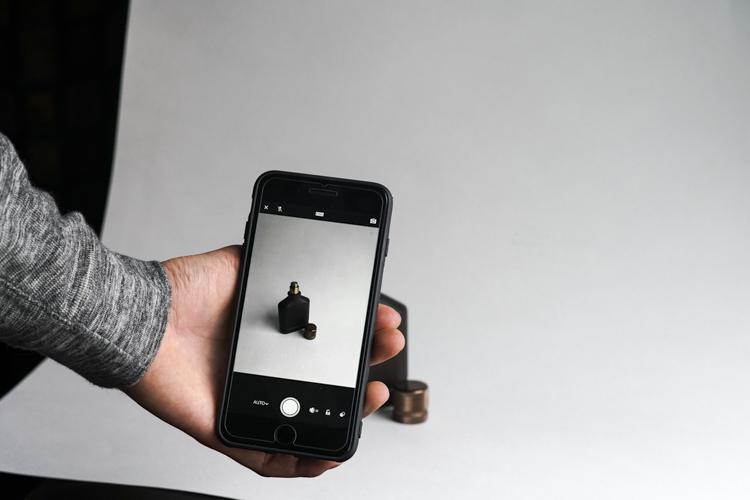
A few central tips when shooting product photos with your smartphone:
- Avoid the zoom feature as this significantly reduces the quality of the image
- Avoid blurry photos by investing in a tripod for your smartphone
- Avoid the selfie photographic camera as the front photographic camera is non equally proficient at the back camera
- Avoid using the wink every bit this will overexpose your photo and distort the colors
- Avoid distracting or dark background, always shoot against a plain white background
- Avoid over editing as this reduces the quality of the photo, minor adjustments only
How to take amazing product photos at home
In this video, you will acquire how to accept product photography at home with a cellphone and on a budget.
Numerous apps can help you get results similar to a DSLR photographic camera. The one I often recommend is Lightroom CC. Within this app, you can control settings such as file format, choosing betwixt JPEG and DNG. DNG provides more than information nigh the image and produce a better quality photo. The downside of using DNG is that it takes upward more storage infinite on your device.
Other factors you can adjust are aspect ratio, timer, grids, and levels, equally well as highlight clipping, which shows you precisely what is overexposed in the paradigm. Once y'all've taken your images, you lot can arrange color, exposure, tone, and contrast inside Lightroom CC.
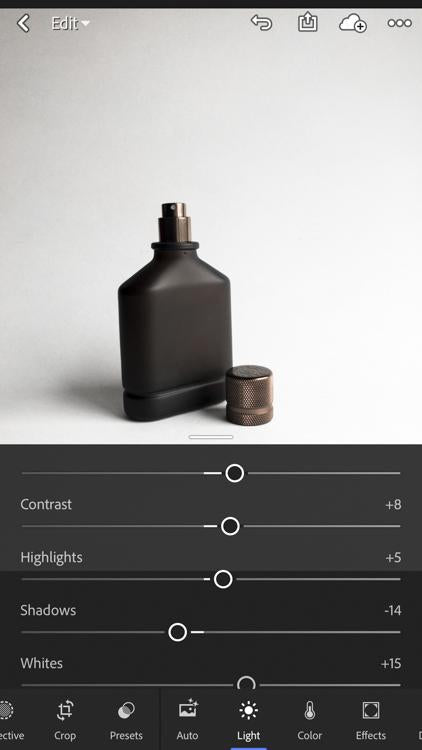
I recommend that you downloaded Lightroom CC on your desktop so that you lot can sync your photos between your desktop and mobile app. I prefer editing photos on the desktop version as I have a bigger screen and tin get a closer wait at what needs to be fixed.
half dozen. Shoot your production photos
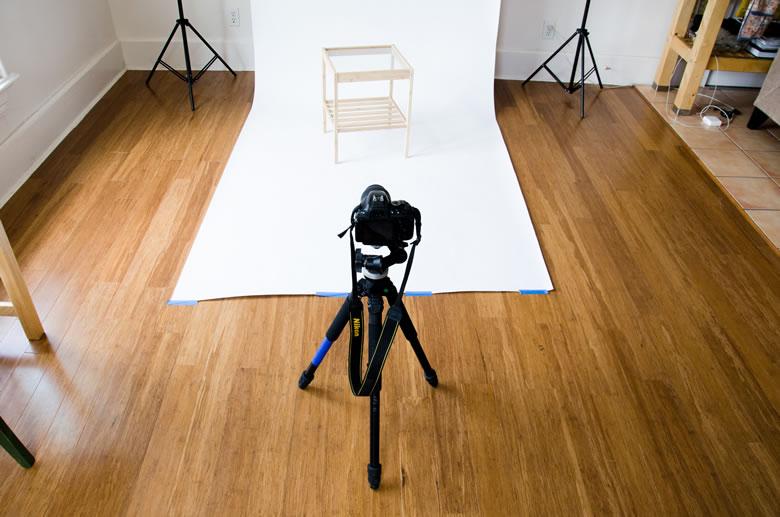
Now that you've got everything set up, information technology's fourth dimension to starting time taking photos. Undoubtedly you'll accept to adjust things throughout the shoot, but practise makes perfect. Take fun and embrace your creativity. Shoot lots of photos in a variety of dissimilar angles, making a note of the settings you used and what they produced.
Take time between different angles to review the images to encounter if y'all demand to accommodate any settings. If yous have time, I'd suggest you lot upload them to your laptop or computer throughout the shoot and then yous can get up close and personal. Once you've called the all-time photos, it'southward fourth dimension to edit.
To larn more about the basics of photo editing, check out this section of Shopify's DIY Product Photography Guide.
About the author: Rachel Jacobs is Head of Content and Partnerships at Pixc, a leading eCommerce product optimization service. Pixc transforms average product photos into professional person images designed to increase conversions.
How To Set Up Good Lighting For Photos,
Source: https://www.shopify.com/blog/natural-lighting-product-photography
Posted by: eakinyout1935.blogspot.com



0 Response to "How To Set Up Good Lighting For Photos"
Post a Comment